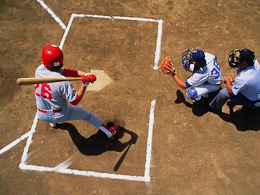Baseball Fitness
One of the oldest professional sports (with origins thought to be as far back as 1344), modern baseball made its initial appearance in America on June 19th, 1846 in Hoboken, New Jersey. Since then, baseball has often been called America's favorite pastime, and its versatility certainly supports such a claim. Baseball can be played either indoors or outdoors. The rules vary little when the location changes. To be played safely, equipment is necessary depending on a player's position. For instance, catchers (players that catch a baseball thrown by a pitcher) are required to catch a baseball traveling at speeds of up to 120 mph. As such, his or her equipment is among the most substantial. For most other players on the field, all that is needed are comfortable clothes, a baseball glove to catch the baseball, a bat and helmet when batting, and usually a baseball cap to protect the eyes from the sun. Baseball requires the participant to be able to sprint for distances of around 90 feet, and sometimes quickly change directions. In addition, upper body strength is desirable when batting or throwing the baseball. Playing The GameThe rules of baseball have remained largely unchanged since it made its first appearance in America. Typically, two teams of 9 players each compete over a series of 9 innings. The winner of the game is determined by which team has earned the most runs at the end of play. An inning consists of 6 "outs" which are divided into 3 outs per team. The team that is at bat is the only team that can receive an out during an inning. Ways to receive an out include:
The players run around a field that contains an infield (4 bases) and an outfield. To score a run, an offensive player must run around all four bases and cross the home base (the fourth base). An offensive player can progress from one base to another in a variety of ways:
A pitcher throws the baseball from the pitcher's mound (90 feet from the batter's box surrounding home plate) and attempts to cause the batter to swing their bat at the baseball and miss hitting the pitch. If the batter does not swing at the baseball (or does and misses it) and the baseball crosses the strike zone (area immediately above home plate and between the knees and shoulders of the batter), the pitch is considered to be a strike against the batter. If the batter swings and misses the baseball, or if the batter does not swing and the pitch was thrown within the strike zone, a total of three times, the batter is considered out and it is recorded as a strikeout. If the batter does not swing at the pitch and it misses the strike zone, the pitch is considered to be a ball against the pitcher. Four balls in any one player's session at bat will advance the player to first base. Although a struck ball that does not land in the field of play (a foul ball) is also considered a strike, the final strike cannot occur on a foul ball. Training For BaseballNumber of Sets: 3-4, Number of Repetitions: 15 to 20 Exercise 1
Exercise 2
Exercise 3
Exercise 4
Exercise 5
Exercise 6

Typical Injuries Associated With BaseballTennis Elbow (Lateral Epicondylitis): is a typical cause of pain in the elbow. It is regarded as a cumulative trauma ailment that occurs over a period of time from repeated use of the muscles within the arm and forearm, leading to tiny tears of the tendons. Since this injury is brought on by an overuse of the extensors in the wrist, rest is the top priority for recovery. Employing the R.I.C.E. method (Rest, Ice, Compression and Elevation) is very valuable in reducing pain and swelling. Achilles Tendonitis: Putting too much pressure or stress on the tendon in your foot can result in tiny tears and inflammation and result in this painful injury. The specific area for the injury is the band of tissues that connect the muscles in the rear lower leg and the heel. Using the R.I.C.E. method (Rest, Ice, Compression, Elevation) is helpful in treatment but continuing pain or inflammation may require the assistance of a physical therapist and/or medical professional. Nutritional Information for Baseball PlayersNutrition is very important for baseball players. Of special note is the tradition of eating sunflower seeds while on the bench or in the dug-out. When professional baseball leagues banned chewing tobacco, sunflower seeds were the replacement. Players began chewing sunflower seeds in order to maintain a consistent level of healthy fat and protein throughout the game. Most of your nutritional diet should consist of carbohydrates, healthy fats and protein. Below are additional nutritional tips designed to assist in the consumption of a healthy, balanced and nutritional dietary regime.

|
Copyright © 2025 FitnessHealth101.com All Rights Reserved
FITNESS TOPICS
FITNESS REVIEWS
FITNESS & HEALTH GLOSSARIES

